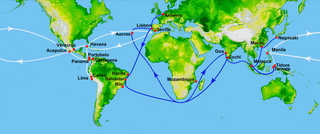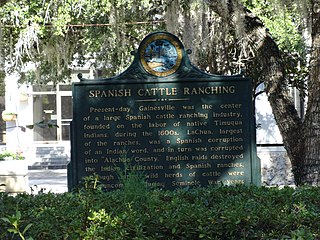Related Research Articles

El Camino Real is the name that the Spanish gave to a trail they cleared in the 1680s, mostly over the traditional trails of Native Americans, from St. Augustine westward to the Spanish missions in north Florida. Before this time, transpeninsular traffic in La Florida between the western mission settlements and the capital depended on water routes from Apalachee to St. Augustine. Agricultural commodities produced in Apalachee were carried by canoes to the Gulf of Mexico and southward on the coast to the mouth of the Suwanee River, then upriver to a location on the Santa Fe River. There they were loaded onto pack animals or the backs of Indian burderners (porters) for the remainder of the overland trip. Provisions and funds from the real situado were sent on the same route in reverse.

The Viceroyalty of Peru, officially known as the Kingdom of Peru, was a Spanish imperial provincial administrative district, created in 1542, that originally contained modern-day Peru and most of the Spanish Empire in South America, governed from the capital of Lima. Peru was one of the two Spanish viceroyalties in the Americas from the sixteenth to the eighteenth centuries.

Spanish America refers to the Spanish territories in the Americas during the Spanish colonization of the Americas. The term "Spanish America" was specifically used during the territories' imperial era between 15th and 19th centuries. To the end of its imperial rule, Spain called its overseas possessions in the Americas and the Philippines "The Indies", an enduring remnant of Columbus's notion that he had reached Asia by sailing west. When these territories reach a high level of importance, the crown established the Council of the Indies in 1524, following the conquest of the Aztec Empire, asserting permanent royal control over its possessions. Regions with dense indigenous populations and sources of mineral wealth attracting Spanish settlers became colonial centers, while those without such resources were peripheral to crown interest. Once regions incorporated into the empire and their importance assessed, overseas possessions came under stronger or weaker crown control.

The Spanish treasure fleet, or West Indies Fleet, was a convoy system of sea routes organized by the Spanish Empire from 1566 to 1790, which linked Spain with its territories in the Americas across the Atlantic. The convoys were general purpose cargo fleets used for transporting a wide variety of items, including agricultural goods, lumber, various metal resources such as silver and gold, gems, pearls, spices, sugar, tobacco, silk, and other exotic goods from the overseas territories of the Spanish Empire to the Spanish mainland. Spanish goods such as oil, wine, textiles, books and tools were transported in the opposite direction.

The Viceroyalty of the Río de la Plata meaning "River of the Silver", also called "Viceroyalty of the River Plate" in some scholarly writings, in southern South America, was the last to be organized and also the shortest-lived of the Viceroyalties of the Spanish Empire in the Americas. The name "Provincias del Río de la Plata" was formally adopted in 1810 during the Cortes of Cádiz to designate the Viceroyalty of the Río de la Plata.

The silver real was the currency of the Spanish colonies in America and the Philippines. In the seventeenth century the silver real was established at two billon reales or sixty-eight maravedíes. Gold escudos were also issued. The coins circulated throughout Spain's colonies and beyond, with the eight-real piece, known in English as the Spanish dollar, becoming an international standard and spawning, among other currencies, the United States dollar. A reform in 1737 set the silver real at two and half billon reales or eighty-five maravedís. This coin, called the real de plata fuerte, became the new standard, issued as coins until the early 19th century. The gold escudo was worth 16 reales de plata fuerte.

Antonio Benavides Bazán y Molina was a Lieutenant General in the Spanish Army who held administrative positions in the Americas as Royal Governor of Spanish Florida (1718–1734), Governor of Veracruz (1734–1745), Governor and Captain General of Yucatán province, as well as Governor of Manila in the Philippines. Before his successive appointments to these various positions, he served with distinction in several campaigns of the War of the Spanish Succession in 1710, and perhaps saved the life of Philip V, the first Bourbon King of Spain, at Guadalajara.
Nicolás Suárez Ponce de León was the accountant for the Royal Treasury of Spanish Florida from 1630 until his death in 1651, and from 1631 to 1633 served as acting co-governor of the colony with Eugenio de Espinosa, when Governor Andrés Rodríguez de Villegas died in office, and also for a few months in 1651.

The Governorate of New Andalusia was a Spanish Governorate of the Crown of Castile in South America which existed between 1534 and 1617.
The Royal Audience and Chancery of Panama in Tierra Firme was a governing body and superior court in the New World empire of Spain. The Audiencia of Panama was the third American audiencia after the ones of Santo Domingo and Mexico. It existed three times under various guises since it first creation in 1538 until its ultimate abolition in 1751.

Colonial Argentina is designated as the period of the History of Argentina when it was an overseas territory of the Spanish Empire. It begins in the Precolumbian age of the indigenous peoples of Argentina, with the arrival of the first Spanish conqueror.
Tomás Menéndez Márquez y Pedroso (1643–1706) was an official in the government of Spanish Florida, and owner, with his brothers, of the largest ranch in Spanish Florida. He was captured by pirates in 1682 and held for ransom, but was rescued by the Timucua.
Francisco Menéndez Márquez y Posada was a royal treasurer and interim co-governor of Spanish Florida, and the founder of a cattle ranching enterprise that became the largest in Florida.
Juan Menéndez Márquez y Valdés (1531–1627) was royal treasurer and interim governor of Spanish Florida, and governor of Popayán Province. He was the father of Francisco Menéndez Márquez, who succeeded him as governor of Florida (1646–1648).
Ramiriáñez Bravo de Saravia (1550–1594) was a Spanish nobleman, who served during the Viceroyalty of Peru as alguacil of the Inquisition, alcalde and regidor of Santiago, Chile.
Bartolomé de Argüelles was the lieutenant treasurer, royal accountant and co-interim governor of La Florida (1595–1597) with Alonso de las Alas and Juan Menéndez Márquez. He served as lieutenant treasurer during the administration of governor Pedro Menéndez de Márquez (1577-1594).
The La Chua ranch was the largest cattle ranch in Spanish Florida in the 17th century. Cattle ranching became an important part of the economy of Spanish Florida over the course of the 17th century. The La Chua ranch was founded in the middle of the 17th century, and by the end of that century accounted for one-third of the cattle in the colony. Raids by the English of the Province of Carolina and their native allies led to the abandonment of the La Chua ranch early in the 18th century.

Cattle ranching was an important industry in Spanish Florida in the second half of the seventeenth century. The Spanish were in Florida for almost a century before ranching became widespread in the colony. Late in the seventeenth century, ranches were located along the middle St. Johns River, in Potano Province, and in Apalachee Province. Ranches flourished despite conflicts with the native people of Florida. Attacks by the English colony, the Province of Carolina, and its native allies brought an abrupt end to ranching in Florida at the beginning of the eighteenth century.
References
- ↑ Rojo, Danna A. Levin; Radding, Cynthia, eds. (2019). The Oxford Handbook of Borderlands of the Iberian World. Oxford University Press. p. 865. ISBN 978-0-19-750770-4.
- ↑ Bushnell, Amy Turner (1994). Situado and Sabana: Spain's Support System for the Presidio and Mission Provinces of Florida. American Museum of Natural History. p. 43. ISBN 978-0-8203-1712-0. Archived from the original (PDF) on 14 October 2008.
When the contract and the concessions were renewed in 1568, the king agreed to a garrison of 150 men to be paid out of the royal subvention for Menendez's Armada of the Indies, funded by the treasuries of Tierra Firme and New Spain in equal parts. Two years later, the Florida situado was separated from that of the armada and a second situado was instituted for Havana. In 1573, when the Tierra Firme treasury split in two to form the treasuries of Nombre de Dios and Panama, the king reassigned the Florida subvention to the treasury of Vera Cruz, official port of the viceroyalty of New Spain.
- 1 2 Enciso, A. González (2016). War, Power and the Economy: Mercantilism and state formation in 18th-century Europe. Routledge. p. 81. ISBN 978-1-317-51822-8.
- 1 2 3 Sánchez, Rafael Torres (2015). Constructing a Fiscal Military State in Eighteenth Century Spain. Springer. p. 102. ISBN 978-1-137-47866-5.
- ↑ Klein, Herbert S. (1 August 1973). "Structure and Profitability of Royal Finance in the Viceroyalty of the Río de la Plata in 1790". Hispanic American Historical Review. 53 (3): 442. doi: 10.1215/00182168-53.3.440 .
- ↑ Marichal, Carlos; Mantecón, Matilde Souto (1 November 1994). "Silver and Situados: New Spain and the Financing of the Spanish Empire in the Caribbean in the Eighteenth Century". Hispanic American Historical Review. 74 (4): 588–589. doi: 10.1215/00182168-74.4.587 .
- ↑ Lacoste, P. 2005. El vino y la nueva identidad de Chile. Revista Universum , 20, 24–33.